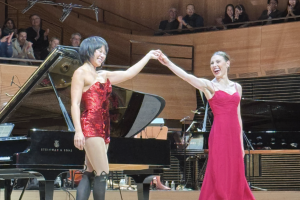Students Discuss What It Means To Be a Minority
October 4, 2012
According to the Office of Institutional Research at FCLC, 33.9 percent of students identify as a minority, with Hispanic and Latino students making up the largest minority group at 15.4 percent for Fall 2011.
Compared to other universities around the country, or even to Fordham College at Rose Hill (FCRH), Fordham College at Lincoln Center (FCLC) is home to students and faculty of nearly every identification of race, religion, ethnicity and sexuality.
Ethnically and racially, FCLC is the most diverse campus excluding the School of Professional and Continuing Studies, which is spread out over the three Fordham campuses. FCLC is home to 52.3 percent white, 15.4 percent Hispanic, 13 percent Asian, .2 percent American Indian and/or Alaskan Native and 5.2 percent black or African Americans. According to the associate vice president of Institutional Research, Donald Gillespie, 6.1 percent of FCLC students identified as international.
The Chronicle of Higher Education recently published its yearly Almanac of Higher Education detailing the demographics, which presents 36 percent of the national college population as those who identified themselves as minorities, compared to the 37 percent in New York State.
Fordham uses the Common Application for students seeking to enroll. The question regarding race and ethnicity is designed to group students into quantifiable categories, first asking the student whether they consider themselves to be Hispanic or Latino.
Regardless of their answer to that question, the applicant is then asked to identify themselves as being one out of five categories: American Indian or Alaskan Native, Asian, Black or African American, Native Hawaiian or Other Pacific Islander, or White (including Middle Eastern). There is no slot for “Other.”
By forcing students to choose to identify themselves by predefined categories, the application neglects to take into account those of mixed heritage, as well as those who would choose to identify themselves outside of the five categories if given the chance.
Those who identified as a minority had different reasons for doing so. “In this world, people of color are not the minority. However, for the census numbers and institutional research I am black and/or mixed,” Lawrence Sealy, FCLC ’13, said. “I identified as a minority in case there was some sort of extra money or scholarship that is associated with being a minority.”
Jeffrey Cipriano, FCLC ’14, said that he identifies as a minority due to his sexuality. “I’m openly gay,” Cipriano said.
Paulina Carvajal, FCLC ’16, said, “I am a minority because there are so many diverse groups of people here at Fordham. At Fordham it seems like no one is really judgmental.”
Erica Freedman, FCLC ’14, said she identifies as a minority student for religious reasons. “I identify as a minority student both on campus at Fordham as well as off-campus. As a young Jewish woman I am and have always been considered a minority in a predominantly neo-Christian society,” Freedman said.
“I guess I do (identify as a minority),” Niam Miah, FCLC ’16, said. “I mean, in Manhattan, I don’t see many other people that look like me or my culture, but at Fordham, I see a lot of people of different cultures. The atmosphere is different.”
Tess Alexander, FCLC ‘14, said she felt differently. “I wouldn’t really identify myself as a minority student at Lincoln Center and I feel like many students are similar to me,” Alexander said. “I’m a white girl from Long Island: pretty average in the Fordham Community.”
Almost all were quick to remark that it was not so much about demographic percentages as it was about inequality.
Cipriano said that being open with his sexuality makes him a second class citizen to a portion of the population. “It’s that I can’t get married in 45 states,” Cipriano said. “It’s that people assume I’ll be a bad parent without knowing how much I love children and want to raise a family.”
Freedman cited the differences in the way religious holidays are observed. “The holidays of Rosh Hashanah and Yom Kippur, two important Jewish holidays, are not days that we have off from school,” Freedman said. “I think there is a pretty large pocket of Jewish students on campus, but in comparison to the Catholic or Christian presence, I’m still the minority.”
Fordham offers numerous extracurricular activities that embrace and cater the needs of its diverse population. It has over 31 cultural and religious organizations. While the Office of Institutional Research did not offer projections for future minority enrollment, national trends towards increased minority presence in universities point to an increasingly diverse student body in the upcoming years.
at Fordham, I see a lot of people of different cultures. The atmosphere is different.”
Tess Alexander, FCLC ’14, said she felt differently. “I wouldn’t really identify myself as a minority student at Lincoln Center because I feel like many students are similar to me,” Alexander said. “I’m a white girl from Long Island: pretty average in the Fordham community.”
Almost all were quick to remark that it was not so much about demographic percentages as it was about inequality.
Cipriano said that being open with his sexuality makes him a second class citizen to a portion of the population. “It’s that I can’t get married in 45 states,” Cipriano said. “It’s that people assume I’ll be a bad parent without knowing how much I love children and want to raise a family.”
Freedman cited the differences in the way religious holidays are observed. “The holidays of Rosh Hashanah and Yom Kippur, two important Jewish holidays, are not days that we have off from school,” Freedman said. “I think there is a pretty large pocket of Jewish students on campus, but in comparison to the Catholic or Christian presence, I’m still the minority.”
Fordham offers numerous extracurricular activities that aim to embrace and cater the needs of its diverse population. It has over 31 cultural and religious organizations. While the Office of Institutional Research did not offer projections for future minority enrollment, national trends towards increased minority presence in universities point to an increasingly diverse student body in the upcoming years.












